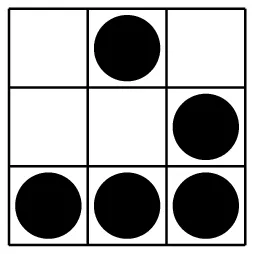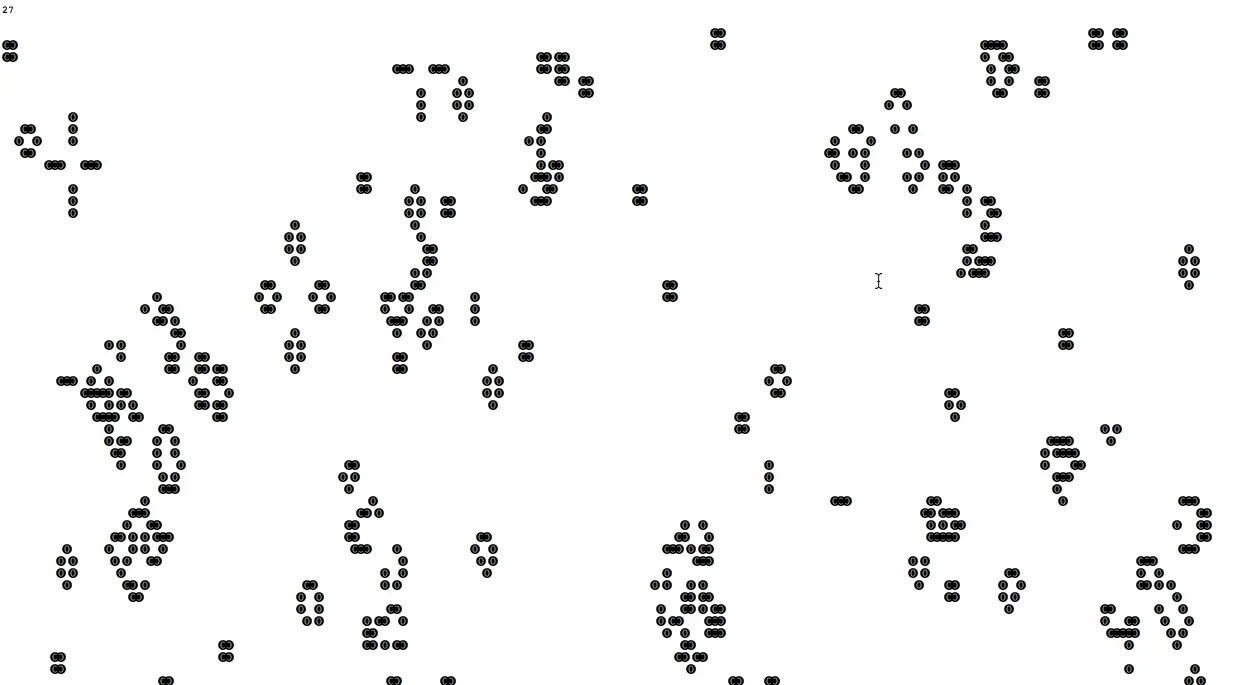
WebSocket-based app with Django Channels and React

Today, I chose to share my exploration of a library that I wanted to try for some time: Django Channels.
I was also curious about how a React application can be plugged to a backend different from a REST API.
Let’s see that with a real example: the Game of Life!
Game of Life
The Conway’s Game of Life is a game that requires enough computation to delegate this role to a backend.
The game’s principle, which needs no player, is to make some cells live through several generations. There are some rules that apply to them, such as biologic ones:
- Any live cell with fewer than two live neighbours dies, as if caused by under-population;
- Any live cell with two or three live neighbours lives on to the next generation;
- Any live cell with more than three live neighbours dies, as if by over-population;
- Any dead cell with exactly three live neighbours becomes a live cell, as if by reproduction.
The point of the app will be to manage the cells life and death from a server, to visualize them from a web client and manage the right to life and death thanks to a manual activation of the new generations.
Game generation and WebSocket delivery
What is django-channels?
If you never heard of Django, I let you check the dedicated web site, it’s very well done. To make it simple, it is a straightforward and complete web framework, based on an MVC architecture and a system built around a request, a response, some middlewares between, and a lot of tools to help “developers with deadlines”.
Django Channels is a beta project recently adopted as an Official Project by the Django Software Foundation.
It is described by its own creators with these few words:
Channels extends Django to add a new layer that allows two important features: WebSocket handling, in a way very similar to normal views; Background tasks, running in the same servers as the rest of Django. It allows other things too, but these are the ones you’ll use to start with.
Channels architecture
The configuration of channels is relatively simple, as wanted by the Django’s rules. It introduces a new layer before HTTP routing.
from channels.routing import routefrom .consumers import http_consumer, ws_add, ws_disconnect, ws_receive
channel_routing = [ route('http.request', http_consumer), # Classic HTTP request handling route('websocket.connect', ws_add), route('websocket.receive', ws_receive), route('websocket.disconnect', ws_disconnect),]We need to associate a consumer to each event.
In the case of our application, we dispatch the roles of each consumer as following:
- HTTP Request: Nothing but warn an eventual visitor (optional)
- WebSocket Connect: Register the new client which will be averted at each game’s state update
- WebSocket Receive: Compute a new life’s generation
- WebSocket Disconnect: Unregister the client for updates
Django Channels gives a concept of client Group in order to make the code very readable.
import json
from django.http import HttpResponsefrom channels import Groupfrom channels.handler import AsgiHandler
from .game import Board
game = Board(75, 75)
def http_consumer(message): response = HttpResponse('Welcome to Game of Life! You should try websockets.')
for chunk in AsgiHandler.encode_response(response): message.reply_channel.send(chunk)
def ws_add(message): Group('game').add(message.reply_channel) message.reply_channel.send({ 'text': json.dumps(game.current_generation), })
def ws_receive(message): game.new_generation() Group('game').send({ 'text': json.dumps(game.current_generation), })
def ws_disconnect(message): Group('game').discard(message.reply_channel)Here, the game behavior is to generate a 75*75 grid with default fixture.
game.current_generation returns the game matrix as well as the generation number, and game.new_generation() computes a new cell generation from the previous one.
You will note that the game variable is in the consumers scope.
Therefore, all clients share the same game’s state and are all warned at the same time when a new generation is delivered.
We now have a game of life computed in the backend! Let’s see how we can handle it from front-end.
Frontend with React & Redux
Game display
The representation of the game is a simple 2D matrix. Hence, we only have to create a grid which two basic loops.
const Grid = ({ matrix }) => ( <div className="grid"> <div className="cell-container"> {matrix.map((column, i) => ( <div key={i} className="column"> {column.map((cell, j) => ( <Cell key={j} {...cell} /> ))} </div> ))} </div> </div>);
// Cell.jsconst Cell = ({ state }) => <div className={`cell ${state}`} />;The state can be either empty or alive.
WebSocket handling
The most interesting part.
I tried some ways to imitate the native WebSocket behavior through a socket reducer and a few actions.
redux-saga gives powerful tools to easily code some complex behaviors, but in the end, redux allows to resolve the problem with a simple and elegant solution:
import { createAction } from "redux-actions";
export const actionsTypes = { CONNECTING: "SOCKET_CONNECTING", OPENED: "SOCKET_OPENED", MESSAGED: "SOCKET_MESSAGED", ERROR: "SOCKET_ERROR", CLOSED: "SOCKET_CLOSED",};
export default { connect: createAction(actionsTypes.CONNECTING), open: createAction(actionsTypes.OPENED), message: createAction(actionsTypes.MESSAGED), error: createAction(actionsTypes.ERROR), close: createAction(actionsTypes.CLOSED),};import { createAction } from "redux-actions";
export const actionsTypes = { NEW_STATE: "GAME_NEW_STATE",};
export default { newState: createAction(actionsTypes.NEW_STATE),};import { actionsTypes } from "./actions";
const initialState = { loading: false, connected: false, error: null, message: null,};
const reducer = (state = initialState, { type, payload }) => { switch (type) { case actionsTypes.CONNECTING: return { ...state, loading: true, }; case actionsTypes.OPENED: return { ...state, connected: true, loading: false, }; case actionsTypes.MESSAGED: return { ...state, ...payload, }; case actionsTypes.ERROR: return { ...state, ...payload, loading: false, }; case actionsTypes.CLOSED: return { ...state, loading: false, connected: false, }; default: return state; }};
export default reducer;import actions from "./actions";import gameActions from "../life/actions";
export default (dispatch) => (uri) => { if (!("WebSocket" in window)) { dispatch( actions.error({ error: "WebSocket is not supported by your browser" }), ); return; }
const socket = new WebSocket(uri); dispatch(actions.connect());
socket.onopen = () => dispatch(actions.open({ instance: socket })); socket.onerror = () => dispatch(actions.error({ error: true })); socket.onmessage = (evt) => dispatch(gameActions.newState({ ...JSON.parse(evt.data) })); socket.onclose = () => dispatch(actions.close());};Root assembly
Our final application now have all it needs to use the computational power of the django backend to generate a game of life.
import initSocketFactory from "../socket/initSocket";
class App extends Component { componentDidMount() { this.props.initSocket("ws://localhost:8000"); }
render() { const { socket, game, initSocket } = this.props; const loading = socket.loading || !game.matrix.length; 2;
return ( <div> {loading && <span>Loading...</span>} {!loading && <Grid matrix={game.matrix} />} </div> ); }}
const mapDispatchToProps = (dispatch) => ({ initSocket: initSocketFactory(dispatch),});
export default connect((store) => store, mapDispatchToProps)(App);Finally, with a bit of Material UI.

What’s next?
The entire project is open-source and available on Github: https://github.com/Kmaschta/GameOfLife
It deserves some love and I still have to learn a lot. The evolution algorithm is not very efficient, we can imagine two generation modes “auto/manually” or the capacity to start from different fixtures.
To do so, it misses a reliable protocol to manage sent messages. The Web Application Messaging Protocol (WAMP) is a good candidate and I strongly recommend to take it a look.
I may write a next part if I implement this protocol in my little project. Let me know if you are interested!
Authors

Full-stack web developer at marmelab, Kevin also shows impressive sysadmin skills, and a passion for obscure cryptocurrencies. Oh, and don't challenge him at fussbal, unless you're a champion.
